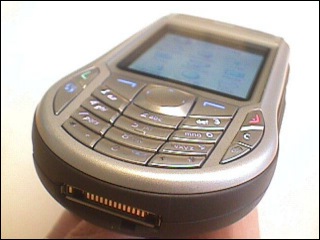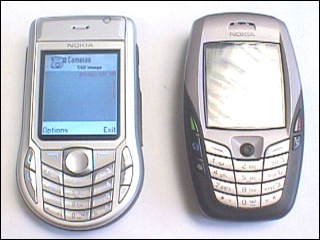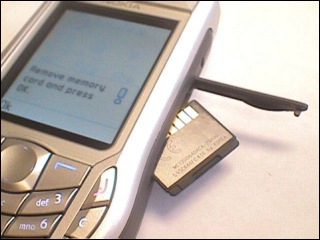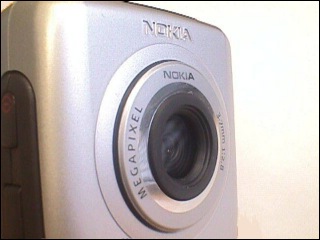 Nokia's 3G Series 60 handset is cute. So cute it reminds of a Mini Cooper - the little car that everyone went "awww... cute" and completely ignored, until Paddy Hopkirk took it on to storm the Monte Carlo Rally in 1964. The 6630 is just like that, it's small, has a funky form factor, but when you start to use it... wow!
Nokia's 3G Series 60 handset is cute. So cute it reminds of a Mini Cooper - the little car that everyone went "awww... cute" and completely ignored, until Paddy Hopkirk took it on to storm the Monte Carlo Rally in 1964. The 6630 is just like that, it's small, has a funky form factor, but when you start to use it... wow!
Looking at you'd think it's quite small, and even in the hand is definitely a pocketable phone. It's only when you put it next to the base design model in the Nokia 6600 that you realise that it's pretty much the same size as the 6600. Everything that the 6600 has is in the 6630 as well. It looks to be the same screen (it's the same physical size if nothing else). The same goes for the keypad, all the keys and the dimensions are the same size as the 6600 apart from one slightly annoying feature... the pencil/abc key is on the left hand side of the 6600, and the right hand side on the 6630. Now that may not seem like a lot to you, but when you're switching between phones and your thumb instinctively knows where to push to get Cap Lock, this sort of wholesale switch is something that can drive you to distraction.
 The shape itself, with the rounded bottom and straight edges is much more 'hip' - if it wasn't for the switch to RS-MMC from full size MMC, I would have guessed they had the same circuit board. The switch to RS-MMC is a big talking point. Obviously everyone has a nice collection of large capacity MMC cards, so why are Nokia making the switch? Having a smaller card does make for a tidier internal layout, and with size a key selling point nowadays, any saving to a manufacturer is a bonus. At least the RS-MMC cards can be plugged into a 'sleeve' and act as a full size MMC card in devices like the 9500. What's disappointing is how the RS-MMC is implemented in the 6630.
The shape itself, with the rounded bottom and straight edges is much more 'hip' - if it wasn't for the switch to RS-MMC from full size MMC, I would have guessed they had the same circuit board. The switch to RS-MMC is a big talking point. Obviously everyone has a nice collection of large capacity MMC cards, so why are Nokia making the switch? Having a smaller card does make for a tidier internal layout, and with size a key selling point nowadays, any saving to a manufacturer is a bonus. At least the RS-MMC cards can be plugged into a 'sleeve' and act as a full size MMC card in devices like the 9500. What's disappointing is how the RS-MMC is implemented in the 6630.
It's behind a swing door in the side of the machine, and you have to push-click the RS-MMC card into the holder. Because it goes in contact-side first, it's physically possible to put in a full size MMC card, hear it go click and make contact with the circuit board. Unfortunately the software won't register the card unless the swing door is closed... which you can't do with a full size card in place.
 So yet again a smooth route to upgrade your data from a previous Series 60 device. We're into the sort of the 'third' iteration devices from Nokia (the 7650 and 3650 being the first, the 6600 and N-Gage as the second, and the 6630 as the third) so it's a fair bet that a significant number of 6630 adopters will be current users looking for 3G Speeds. Data retention is a strong point of Nokia's Communicators, but it's lacking in the Series 60 range - a set of phones that's almost designed to burn out and be replaced with new-featured phones every year.
So yet again a smooth route to upgrade your data from a previous Series 60 device. We're into the sort of the 'third' iteration devices from Nokia (the 7650 and 3650 being the first, the 6600 and N-Gage as the second, and the 6630 as the third) so it's a fair bet that a significant number of 6630 adopters will be current users looking for 3G Speeds. Data retention is a strong point of Nokia's Communicators, but it's lacking in the Series 60 range - a set of phones that's almost designed to burn out and be replaced with new-featured phones every year.
Let's talk about some nice things though, and there are quite a bit of them. The camera for one. It's a megapixel camera, with a larger lens than most of the current phones (it's a 3.7mm focal length lens, as opposed to 3.5mm on existing phones). The extra length here means the lens does stick out of the back of the phone, so no lying the phone down flat. We've a digital zoom with ten levels of magnification, and it's a lot smoother moving between these and the 2x Zoom on the 6600. Quality is pretty much what you've come to expect from the smartphone. Great in good light and bit iffy if it's darker.
 The 6630's application suite doesn't have any surprises in it. We've got all the usual suspects from the baseline 6600, as well as the Presence/Location application, The Quick Suite range of applications for viewing Word and Powerpoint files is included as well, along with a Printer module from HP, and Kodak Mobile imaging printing. All well done app that while don’t make a huge fuss, do what they need to do, and lift the Series 60 from the "workmanlike" tag to a smartphone that can actually do a fair bit for you on a day to day basis.
The 6630's application suite doesn't have any surprises in it. We've got all the usual suspects from the baseline 6600, as well as the Presence/Location application, The Quick Suite range of applications for viewing Word and Powerpoint files is included as well, along with a Printer module from HP, and Kodak Mobile imaging printing. All well done app that while don’t make a huge fuss, do what they need to do, and lift the Series 60 from the "workmanlike" tag to a smartphone that can actually do a fair bit for you on a day to day basis.
But it's 3G that really lifts this phone up though. Vodafone's 3G service is going to be looking at handsets like this to make their service profitable. Once we get a unit with a 3G sim in it, we'll let you know how much difference this final step makes to an impressive phone. It might not be much different to the Series 60 baseline, but then that baseline is already astounding enough to people who are new to the UI.
